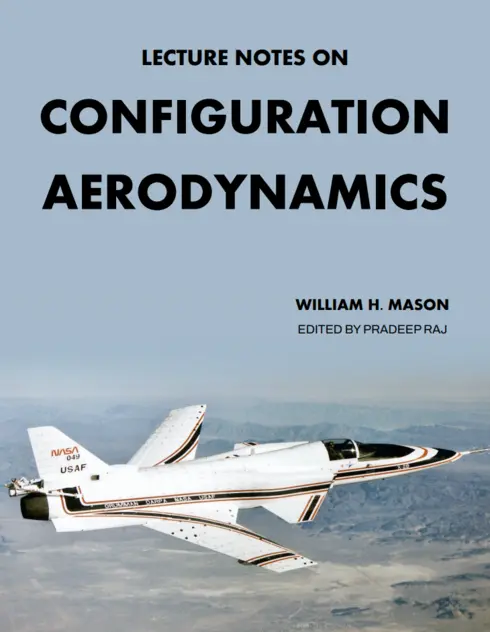
Lecture Notes on Configuration Aerodynamics
In DevelopmentWilliam H. Mason, Blacksburg, VA
Pradeep Raj, Blacksburg, VA
Estimated Publication: January 2026
Publisher: Virginia Tech Publishing
Language: English
Conditions of Use
![]() Attribution-NonCommercial-ShareAlike
Attribution-NonCommercial-ShareAlike
CC BY-NC-SA
Table of Contents
1. Introduction to Configuration Aerodynamics
2. Fluid Mechanics Foundations: Governing Equations
3. Fundamentals of Aerodynamic Drag
4. Overview of Configuration Aerodynamic Design and the Use of Computational Aerodynamics
5. Subsonic Aerodynamics of Airfoils and Wings
6. Transonic Aerodynamics of Airfoils and Wings
7. High-Lift Aerodynamics
8. High Angle of Attack (Hi-α) Aerodynamics
9. Supersonic Aerodynamics
10. Hypersonic Aerodynamics
11. End note
Appendix A. Geometry for Aerodynamicists
Appendix B. Fifteen Minutes of Stealth in Aircraft Design
Appendix C. FAR and Mil Requirements Affecting Configuration Aerodynamics
Appendix D. Examples of Aerodynamic Design
Appendix E. Software for Aerodynamics and Aircraft Design
Appendix F. Configuration Aerodynamics Reading List
Appendix G. The Configuration Aerodynamicist's Bookshelf
About the Contributors
Author
William H. Mason (1947-2019) developed a deep passion for airplanes quite early in his life. Growing up in southwest Virginia, he spent countless hours building and flying model airplanes as a teenager. When he was an undergraduate student at Virginia Tech, he seized upon the opportunities for gaining practical experience during summers working at McDonnell Douglas in St. Louis, Missouri, on various F-4 aircraft projects including the ‘swing wing’ F-4, and at the Edwards Air Force Base, California, on the U.S. Army Huey Cobra helicopters. In 1974, he began his 15-year professional aerospace engineering career with Grumman, and made valuable contributions to many high-profile projects. Examples include: (i) the X-29, an experimental aircraft with a forward-swept wing and canard; (ii) the NASA/Grumman Research Fighter Configuration with supercruise and maneuvering capabilities; and (iii) the SC3 Wing Concept which set a record for low drag at high-lift supersonic performance. From 1989 until his passing in 2019, he was a dedicated educator at Virginia Tech. Right after returning to VT in 1989, he devoted himself to sharing his knowledge and insights with students and colleagues. His legacy lives on with a large number of students who either took the courses he offered in aircraft design; applied computational aerodynamics; and configuration aerodynamics or performed research in aerospace systems design and multidisciplinary optimization. He co-authored Applied Computational Aerodynamics: A Modern Engineering Approach—one of the first textbooks for undergraduates—published by Cambridge University Press in 2015. He also authored or co-authored more than 100 technical papers and reports. He was a lifelong Hokie having earned his B.S. degree in 1971, a M.S. in 1972, and a Ph.D. in 1975, all in aerospace engineering from Virginia Tech. Mason was an Associate Fellow of the American Institute of Aeronautics and Astronautics (AIAA).
Editor
Pradeep Raj is a Collegiate Professor Emeritus at Virginia Tech (VT) after 12 years of serving as a faculty advisor of student capstone aircraft design teams and conducting collaborative research in simulation driven design to enable development of quality affordable aerial vehicles. He joined VT in 2012 after 32 years (1979-2011) with Lockheed Martin, a premier aerospace and defense corporation. For the first 20 years there, he held key technical leadership positions and made noteworthy contributions to advancing the effectiveness of computational simulation capabilities for meeting aircraft design needs. For the next 12 years, he held executive leadership and management positions before retiring from the Advanced Development Programs organization commonly known as the Skunk Works® which is world renowned for creating breakthrough technologies and landmark aircraft. He is a Fellow of the American Institute of Aeronautics and Astronautics (AIAA) and of the Royal Aeronautical Society (RAeS). He earned a Ph.D. in Aerospace Engineering from Georgia Institute of Technology in 1976 after earning a master’s degree in aeronautical engineering and a bachelor’s in electrical technology, both from Indian Institute of Science in Bangalore, India.
